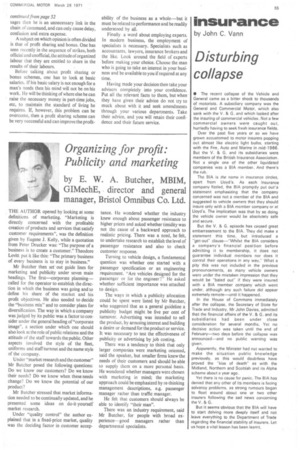Organizing for profit: Publicity and marketing
Page 57

If you've noticed an error in this article please click here to report it so we can fix it.
by E. W. A. Butcher, MBIM, GIMechE, director and general manager, Bristol Omnibus Co. Ltd.
THE AUTHOR opened by looking at some definitions of marketing. "Marketing is directly concerned with the profitable creation of products and services that satisfy customer requirements", was the definition given by Eugene J. Kelly, while a quotation from Peter Drucker was: "The purpose of a business is to create a customer." Theodore Levitt put it like this: "The primary business of. every business is to stay in business."
Mr Butcher then set out guide lines for marketing and publicity under seven main headings. The first—corporate planning-called for the operator to establish the direction in which the business was going and to define his share of the market and his profit objectives. He also needed to decide the "business mix" and to consider plans for diversification. The way in which a company was judged by its public was a factor to consider under the general heading of "corporate image", a section under which one should also look at the role of public relations and the attitude of the staff towards the public. Other aspects involved the style of the fleet, uniforms and staff turnout and the name style of the company.
Under "market research and the customer" Mr Butcher posed the following questions: Do we know our customers? Do we know their needs? Do we know when these needs change? Do we know the potential of our product?
Mr Butcher stressed that market information needed to be continually updated, and he presented some ideas on do-it-yourself market research.
Under "quality control" the author explained that in a fixed-price market, quality was the deciding factor in customer accep
tance. He wondered whether the industry knew enough about passenger resistance to higher prices and asked whether timidity was not the cause of a backward approach to realistic pricing. There was a need, he felt, to undertake research to establish the level of passenger resistance and also to check custonier response.
Turning to vehicle design, a fundamental question was whether one started with a passenger specification or an engineering requirement. -Are vehicles designed for the passenger or for the engineer?' He asked whether sufficient importance was attached to design.
The ways in which a publicity allocation could be spent were listed by Mr Butcher, who suggested that as a general guideline a publicity budget might be five per cent of turnover. Advertising was intended to sell the product, by arousing interest and building a desire or demand for the product or service. It was necessary to test the effectiveness of publicity or advertising by job costing.
There was a tendency to think that only larger companies were marketing oriented, said the speaker, but smaller firms knew the needs of their customers and should be able to supply them on a more personal basis. He wondered whether managers were chosen with marketing in mind; the marketing approach could be emphasized by re-thinking management descriptions, e.g. passenger manager rather than traffic manager.
He felt that customers should always be able to identify "their man".
There was an industry requirement, said Mr Butcher, for people with broad experience—good managers rather than departmental specialists.














































































































